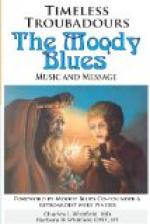Thus, whatever may have been the origin of troubadour poetry, it appears at the outset of the twelfth century as a poetry essentially aristocratic, intended for nobles and for courts, appealing but rarely to the middle classes and to the common people not at all. The environment which enabled this poetry to exist was provided by the feudal society of Southern France. Kings, princes and nobles themselves pursued the art and also became the patrons of troubadours who had risen from the lower classes. Occasionally troubadours existed with sufficient resources of their own to remain independent; Folquet of Marseilles seems to have been a merchant of wealth, above the necessity of seeking patronage. But troubadours such as Bernart de Ventadour, the son of the [11] stoker in the castle of Ventadour, Perdigon the son of a fisherman, and many others of like origin depended for their livelihood and advancement upon the favour of patrons. Thus the troubadour ranks included all sorts and conditions of men; monks and churchmen were to be found among them, such as the monk of Montaudon and Peire Cardenal, though the Church looked somewhat askance upon the profession. Women are also numbered among the troubadours; Beatrice, the Countess of Die, is the most famous of these.
A famous troubadour usually circulated his poems by the mouth of a joglar (Northern French, jongleur), who recited them at different courts and was often sent long distances by his master for this purpose. A joglar of originality might rise to the position of a troubadour, and a troubadour who fell upon evil days might sink to the profession of joglar. Hence there was naturally some confusion between the troubadour and the joglar, and poets sometimes combined the two functions. In course of time the joglar was regarded with some contempt, and like his forbear, the Roman joculator, was classed with the jugglers, acrobats, animal tamers and clowns who amused the nobles after their feasts. Nor, under certain conditions, was the troubadour’s position one of dignity; [12] when he was dependent upon his patron’s bounty, he would stoop to threats or to adulation in order to obtain the horse or the garments or the money of his desire; such largesse, in fact, came to be denoted by a special term, messio. Jealousy between rival troubadours, accusations of slander in their poems and quarrels with their patrons were of constant occurrence. These naturally affected the joglars in their service, who received a share of any gifts that the troubadour might obtain.




